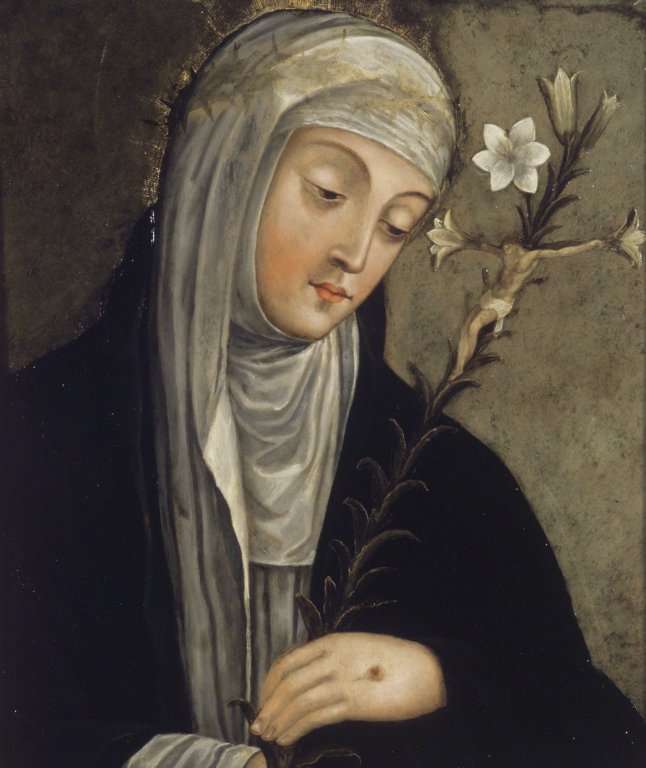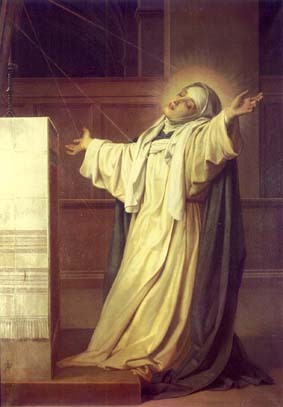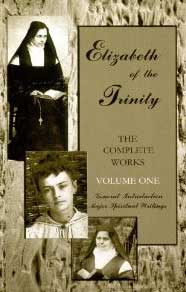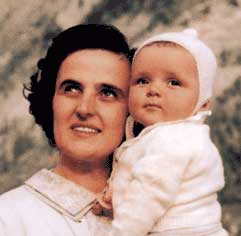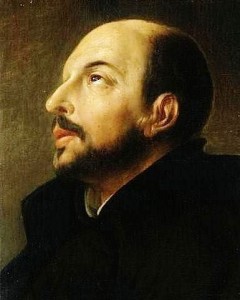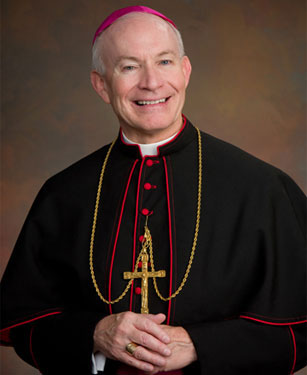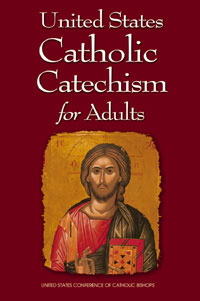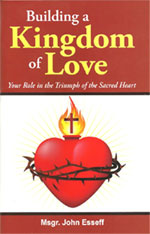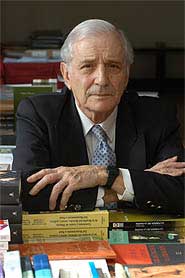Dominican Tertiary, born at Siena, 25 March, 1347; died at Rome, 29 April, 1380.
From the Catholic Encyclopedia, found at New Advent –
She was the youngest  one of a very large family. Her father, Giacomo di Benincasa, was a dyer; her mother, Lapa, the daughter of a local poet. They belonged to the lower middle-class faction of tradesmen and petty notaries, known as “the Party of the Twelve”, which between one revolution and another ruled the Republic of Siena from 1355 to 1368. From her earliest childhood Catherine began to see visions and to practise extreme austerities. At the age of seven she consecrated her virginity to Christ; in her sixteenth year she took the habit of the Dominican Tertiaries, and renewed the life of the anchorites of the desert in a little room in her father’s house. After three years of celestial visitations and familiar conversation with Christ, she underwent the mystical experience known as the “spiritual espousals”, probably during the carnival of 1366. She now rejoined her family, began to tend the sick, especially those afflicted with the most repulsive diseases, to serve the poor, and to labour for the conversion of sinners.Though always suffering terrible physical pain, living for long intervals on practically no food save the Blessed Sacrament, she was ever radiantly happy and full of practical wisdom no less than the highest spiritual insight. All her contemporaries bear witness to her extraordinary personal charm, which prevailed over the continual persecution to which she was subjected even by the friars of her own order and by her sisters in religion.
She began to gather disciples round her, both men and women, who formed a wonderful spiritual fellowship, united to her by the bonds of mystical love. During the summer of 1370 she received a series of special manifestations of Divine mysteries, which culminated in a prolonged trance, a kind of mystical death, in which she had a vision of Hell, Purgatory, and Heaven, and heard a Divine command to leave her cell and enter the public life of the world. She began to dispatch letters to men and women in every condition of life, entered into correspondence with the princes and republics of Italy, was consulted by the papal legates about the affairs of the Church, and set herself to heal the wounds of her native land by staying the fury of civil war and the ravages of faction. She implored the pope, Gregory XI, to leave Avignon, to reform the clergy and the administration of the Papal States, and ardently threw herself into his design for a crusade, in the hopes of uniting the powers of Christendom against the infidels, and restoring peace to Italy by delivering her from the wandering companies of mercenary soldiers. While at Pisa, on the fourth Sunday of Lent, 1375, she received the Stigmata, although, at her special prayer, the marks did not appear outwardly in her body while she lived.
Mainly through the misgovernment of the papal officials, war broke out between Florence and the Holy See, andalmost the whole of the Papal States rose in insurrection. Catherine had already been sent on a mission from the pope to secure the neutrality of Pisa and Lucca.
In June, 1376, she went to Avignon as ambassador of the Florentines, to make their peace; but, either through the bad faith of the republic or through a misunderstanding caused by the frequent changes in its government, she was unsuccessful. Nevertheless she made such a profound impression upon the mind of the pope, that, in spite of the opposition of the French king and almost the whole of the Sacred College, he returned to Rome (17 January, 1377).
Catherine spent the greater part of 1377 in effecting a wonderful spiritual revival in the country districts subject to the Republic of Siena, and it was at this time that she miraculously learned to write, though she still seems to have chiefly relied upon her secretaries for her correspondence. Early in 1378 she was sent by Pope Gregory to Florence, to make a fresh effort for peace. Unfortunately, through the factious conduct of her Florentine associates, she became involved in the internal politics of the city, and during a popular tumult (22 June) an attempt was made upon her life. She was bitterly disappointed at her escape, declaring that her sins had deprived her of the red rose of martyrdom. Nevertheless, during the disastrous revolution known as “the tumult of the Ciompi”, she still remained at Florence or in its territory until, at the beginning of August, news reached the city that peace had been signed between the republic and the new pope. Catherine then instantly returned to Siena, where she passed a few months of comparative quiet, dictating her “Dialogue”, the book of her meditations and revelations.
In the meanwhile the Great Schism had broken out in the Church. From the outset Catherine enthusiastically adhered to the Roman claimant, Urban VI, who in November, 1378, summoned her to Rome. In the Eternal City she spent what remained of her life, working strenuously for the reformation of the Church, serving the destitute and afflicted, and dispatching eloquent letters in behalf of Urban to high and low in all directions. Her strength was rapidly being consumed; she besought her Divine Bridegroom to let her bear the punishment for all the sins of the world, and to receive the sacrifice of her body for the unity and renovation of the Church; at last it seemed to her that the Bark of Peter was laid upon her shoulders, and that it was crushing her to death with its weight. After a prolonged and mysterious agony of three months, endured by her with supreme exultation and delight, from Sexagesima Sunday until the Sunday before the Ascension, she died. Her last political work, accomplished practically from her death-bed, was the reconciliation of Pope Urban VI with the Roman Republic (1380).
Among Catherine’s principal followers were Fra Raimondo delle Vigne, of Capua (d. 1399), her confessor and biographer, afterwards General of the Dominicans, and Stefano di Corrado Maconi (d. 1424), who had been one of her secretaries, and became Prior General of the Carthusians. Raimondo’s book, the “Legend”, was finished in 1395. A second life of her, the “Supplement”, was written a few years later by another of her associates, Fra Tomaso Caffarini (d. 1434), who also composed the “Minor Legend”, which was translated into Italian by Stefano Maconi. Between 1411 and 1413 the depositions of the surviving witnesses of her life and work were collected at Venice, to form the famous “Process”. Catherine was canonized by Pius II in 1461. The emblems by which she is known in Christian art are the lily and book, the crown of thorns, or sometimes a heart–referring to the legend of her having changed hearts with Christ. Her principal feast is on the 30th of April, but it is popularly celebrated in Siena on the Sunday following. The feast of her Espousals
is kept on the Thursday of the carnival.
The works of St. Catherine of Siena rank among the classics of the Italian language, written in the beautiful Tuscan vernacular of the fourteenth century. Notwithstanding the existence of many excellent manuscripts, the printed editions present the text in a frequently mutilated and most unsatisfactory condition. Her writings consist of
the “Dialogue”, or “Treatise on Divine Providence”;
a collection of nearly four hundred letters; and
a series of “Prayers”.The “Dialogue” especially, which treats of the whole spiritual life of man in the form of a series of colloquies between the Eternal Father and the human soul (represented by Catherine herself), is the mystical counterpart in prose of Dante’s “Divina Commedia”.
A smaller work in the dialogue form, the “Treatise on Consummate Perfection”, is also ascribed to her, but is probably spurious. It is impossible in a few words to give an adequate conception of the manifold character and contents of the “Letters”, which are the most complete expression of Catherine’s many-sided personality. While those addressed to popes and sovereigns, rulers of republics and leaders of armies, are documents of priceless value to students of history, many of those written to private citizens, men and women in the cloister or in the world, are as fresh and illuminating, as wise and practical in their advice and guidance for the devout Catholic today as they were for those who sought her counsel while she lived. Others, again, lead the reader to mystical heights of contemplation, a rarefied atmosphere of sanctity in which only the few privileged spirits can hope to dwell. The key-note to Catherine’s teaching is that man, whether in the cloister or in the world, must ever abide in the cell of self-knowledge, which is the stable in which the traveller through time to eternity must be born again.
More on St. Catherine of Siena
Tags: catholic, catholic podcast, catholic prayer, cathollc spirituality, doctor of the church, mystic, mystical experience, prayer
This entry was posted on Sunday, April 29th, 2012 at 12:55 am
You can follow any responses to this entry through the RSS 2.0 feed.
Holy Mary
Holy Repentance
Tags: catherine of siena, catholic, catholic podcast, catholic prayer, cathollc spirituality, Holy Mary
This entry was posted on Sunday, April 29th, 2012 at 12:54 am
You can follow any responses to this entry through the RSS 2.0 feed.
Episode 13 Beginning to Pray: Â “Heaven in Faith” Â Day 7 Prayer 1 – “God chose us in Him before creation, that we should be holy and immaculate in His presence, in love.“
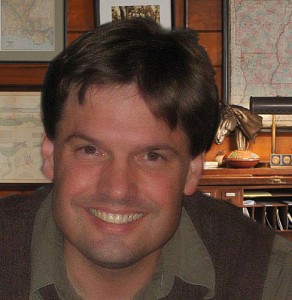
[powerpress]
Dr. Anthony Lilles is a Catholic husband and father of three teaching Spiritual Theology at St. John Vianney Theological Seminary. He  teaches spiritual theology and spiritual direction to transitional deacons, and the spiritual classics to the men who enter the Spirituality Year, a year of prayer in preparation for seminary formation.  He is the author of the “Beginning to Pray”  catholic blog spot.
From “Heaven in Faith: Day 7 Prayer 1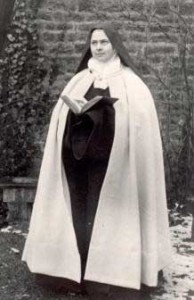 ” found in The Complete Works vol 1:
” found in The Complete Works vol 1:
22. Â “Our created essence asks to be rejoined with its principle”, The Word, “the Splendor of the Father, is the eternal archtype after which creatures are designed on the day of their creation.” Â This is ‘why God wills that, freed from ourselves, we should stretch out our arms towards our exemplar and possess it,” “rising” above all things “towards our model.” Â “This contemplation opens” The soul “to unexpected horizons.”
For other episodes in the series visit the Discerning Hearts page for Dr. Anthony Lilles
We would like to offer heartfelt thanks to
Miriam Gutierrez for providing for us “the voice” of Blessed Elizabeth for this series
Tags: Anthony Lilles, blessed elizabeth of the trinity, caremelites, catholic, catholic podcast, catholic prayer, cathollc spirituality, Elizabeth of the Trinity Episode 13, heaven in faith, Spiritual Theology, St. John Vianney Theological Seminary
This entry was posted on Saturday, April 28th, 2012 at 9:02 am
You can follow any responses to this entry through the RSS 2.0 feed.
Gianna Beretta Molla (1922-1962)
Gianna Beretta was born in Magenta (Milan) October 4, 1922. Already as a youth she willingly accepted the gift of faith and the clearly Christian education that she received from her excellent parents. As a result, she experienced life as a marvellous gift from God, had a strong faith in Providence and was convinced of the necessity and effectiveness of prayer.
She diligently dedicated herself to studies during the years of her secondary and university education, while, at the same time, applying her faith through generous apostolic service among the youth of Catholic Action and charitable work among the elderly and needy as a member of the St. Vincent de Paul Society. After earning degrees in Medicine and Surgery from the University of Pavia in 1949, she opened a medical clinic in Mesero (near Magenta) in 1950. She specialized in Pediatrics at the University of Milan in 1952 and there after gave special attention to mothers, babies, the elderly and poor.
While working in the field of medicine-which she considered a “mission†and practiced as such-she increased her generous service to Catholic Action, especially among the “very young†and, at the same time, expressed her joie de vivre and love of creation through skiing and mountaineering. Through her prayers and those of others, she reflected upon her vocation, which she also considered a gift from God. Having chosen the vocation of marriage, she embraced it with complete enthusiasm and wholly dedicated herself “to forming a truly Christian familyâ€.
She became engaged to Pietro Molla and was radiant with joy and happiness during the time of their engagement, for which she thanked and praised the Lord. They were married on September 24, 1955, in the Basilica of St. Martin in Magenta, and she became a happy wife. In November 1956, to her great joy, she became the mother of Pierluigi, in December 1957 of Mariolina; in July 1959 of Laura. With simplicity and equilibrium she harmonized the demands of mother, wife, doctor and her passion for life.
In September 1961 towards the end of the second month of pregnancy, she was touched by suffering and the mystery of pain; she had developed a fibroma in her uterus. Before the required surgical operation, and conscious of the risk that her continued pregnancy brought, she pleaded with the surgeon to save the life of the child she was carrying, and entrusted herself to prayer and Providence. The life was saved, for which she thanked the Lord. She spent the seven months remaining until the birth of the child in incomparable strength of spirit and unrelenting dedication to her tasks as mother and doctor. She worried that the baby in her womb might be born in pain, and she asked God to prevent that.
A few days before the child was due, although trusting as always in Providence, she was ready to give her life in order to save that of her child: “If you must decided between me and the child, do not hesitate: choose the child – I insist on it. Save himâ€. On the morning of April 21, 1962, Gianna Emanuela was born. Despite all efforts and treatments to save both of them, on the morning of April 28, amid unspeakable pain and after repeated exclamations of “Jesus, I love you. Jesus, I love you», the mother died. She was 39 years old. Her funeral was an occasion of profound grief, faith and prayer. The Servant of God lies in the cemetery of Mesero (4 km from Magenta).
“Conscious immolation», was the phrase used by Pope Paul VI to define the act of Blessed Gianna, remembering her at the Sunday Angelus of September 23, 1973, as: “A young mother from the diocese of Milan, who, to give life to her daughter, sacrificed her own, with conscious immolationâ€. The Holy Father in these words clearly refers to Christ on Calvary and in the Eucharist.
Gianna was beatified by Pope John Paul II on April 24, 1994, during the international Year of the Family.
Tags: catholic, Catholic Action, catholic podcast, catholic prayer, cathollc spirituality, Gianna Beretta, Gianna Beretta Molla, st. gianna beretta molla
This entry was posted on Saturday, April 28th, 2012 at 8:37 am
You can follow any responses to this entry through the RSS 2.0 feed.
In “7 Keys to Spiritual Wellness,” best-selling author Joe Paprocki provides a prescription for spiritual health based on the rich wisdom of 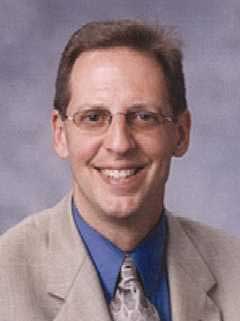 Catholic Tradition.
Catholic Tradition.
The Saints have taught us repeatedly that our souls can get spiritually sick and die as well.
[powerpress]
Joe’s new book focuses on the root causes of spiritual sickness. Each chapter identifies a specific threat to the health of our souls and offers strategies for beating that virus.
His keys to spiritual wellness are:
- Seeing Yourself as You Really Are
- Actively Seeking the Good of Others
- Thinking Before Acting
- Holding on Loosely
- Recognizing and Setting Limits
- Channeling, Not Repressing, Your Desires
- Unleashing Your Imagination
 You can find the book here
You can find the book here
Tags: catholic, catholic podcast, catholic prayer, cathollc spirituality
This entry was posted on Friday, April 27th, 2012 at 10:51 am
You can follow any responses to this entry through the RSS 2.0 feed.
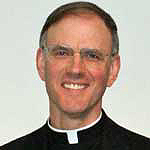 Episode 5Â Praying with Scripture: Christian Contemplation and Mediation in the Ignatian tradition w/Fr. Timothy Gallagher
Episode 5Â Praying with Scripture: Christian Contemplation and Mediation in the Ignatian tradition w/Fr. Timothy Gallagher
Fr. Gallagher continues to discuss the differences and benefits of meditation and contemplation – the cornerstones of Ignatius of Loyola’s spiritual practice.
[powerpress]
For other episodes in the series visit The Discerning Hearts “Praying with Scripture†page
Father Timothy M. Gallagher, O.M.V., was ordained in 1979 as a member of the Oblates of the Virgin Mary, a religious community dedicated to retreats and spiritual formation according to the Spiritual Exercises of St. Ignatius. Â Fr. Gallagher is featured on the EWTN series “Living the Discerning Life: Â The Spiritual Teachings of St. Ignatius of Loyola”.
For more information on how to obtain copies of Fr. Gallaghers’s various books and audio which are available for purchase, please visit  his  website:   frtimothygallagher.org
 For the other episodes in this series check out Fr. Timothy Gallagher’s “Discerning Hearts†page
Tags: catholic, catholic podcast, catholic prayer, cathollc spirituality, Christian Contemplation, Timothy Gallagher, Timothy Gallagher Fr
This entry was posted on Thursday, April 26th, 2012 at 12:39 pm
You can follow any responses to this entry through the RSS 2.0 feed.
Vatican City, 25 April 2012 (VIS) – If prayer and the Word of God do not nourish our spiritual life, we run the risk being
suffocated by the many cares and concerns of daily existence. Prayer makes us see reality with new eyes and helps us to find our way in the midst of adversity. These words were pronounced by Benedict XVI in his catechesis during this morning’s general audience, held in St. Peter’s Square in the presence of more than 20,000 faithful.
The Pope explained how prayer encouraged the early Church, though beset by difficulties, and how it can help man to live a better life today. “Ever since the beginning of her journey the Church has had to face unexpected situations, new questions and emergencies, to which she has sought to respond in the light of the faith, allowing herself to be guided by the Holy Spirit”, he said.
This was already evident at the time of the Apostles. In the Acts, Luke the Evangelist recounts “a serious problem which the first Christian community in Jerusalem had to face and resolve, … concerning the pastoral care of charity towards the isolated and the needy. It was not an unimportant issue and risked creating divisions within the Church. … What stands out is that, at that moment of pastoral emergency, the Apostles made a distinction. Their primary duty was to announce the Word of God according to the Lord’s mandate, but they considered as equally serious the task of … making loving provision for their brothers and sisters in situations of need, in order to respond to Jesus’ command: love one another as I have loved you”.
The Apostles made a clear decision: it was not right for them to neglect prayer and preaching, therefore “seven men of good standing were chosen, the Apostles prayed for the strength of the Holy Spirit, then laid their hands upon them that they might dedicate themselves to the diaconate of charity”.
This decision, the Pope explained, “shows the priority we must give to God and to our relationship with Him in prayer, both as individuals and in the community. If we do not have the capacity to pause and listen to the Lord, to enter into dialogue with Him, we risk becoming ineffectually agitated by problems, difficulties and needs, even those of an ecclesial and pastoral nature”.
Tags: catholic, catholic podcast, catholic prayer, cathollc spirituality
This entry was posted on Thursday, April 26th, 2012 at 11:52 am
You can follow any responses to this entry through the RSS 2.0 feed.
[powerpress = “Vatican_Radio”]
It was the 18th of November 1965 and in Saint Peter’s Basilica the Second Vatican Council was drawing to a close when
during its penultimate session Pope Paul VI promulgated the Dogmatic Constitution on Divine Revelation.
At the time of this ground breaking Council, a young Patrick Kelly now Archbishop of Liverpool was present in Saint Peter’s Basilica witnessing on many an occasion the discussions of the Council Fathers. He shared with Veronica Scarisbrick his memories of that epoch and in a special way of that document on Revelation, gone down in history with the Latin title of ‘Dei Verbum’
Fifty years on from the beginning of that Council back on the 11th of October 1962 , among the events to mark this anniversary is a conference taking place here in Rome on April 26th sponsored by the Pontifical Lateran University and focusing on this same ‘Dei Verbum’ document.
The man to chair this meeting is the Dean of the Faculty of Church History and Fine Arts of the Church at the Pontifical Gregorian University, Jesuit Professor Norman Tanner.In an effort to find out more about ‘Dei Verbum’ Veronica Scarisbrick went round to call on him at the University there and began by asking him how important this document was at the time it was drawn up.
While acknowledging its central role Father Tanner also places it in the broader context of the Council documents and then goes on to highlight the relevance of this document today.
Tags: catholic, catholic podcast, catholic prayer, cathollc spirituality, Council Fathers, Second Vatican Council, vatican radio, Veronica Scarisbrick
This entry was posted on Thursday, April 26th, 2012 at 11:40 am
You can follow any responses to this entry through the RSS 2.0 feed.
USCCA8- Episode 8-Â The Saving Death and Resurrection of Christ
[powerpress]
Archbishop Lucas offers insights on the US Catholic Catechism for Adults Chapter 8:
Because Christ’s suffering and death was the instruments of salvation, from what did he save us? Â We needed to be saved from sin and its damaging effects. Â God’s plan to save us involved having the Son of God enter into this world to be like us in all things except sin. Â Divine love made this possible.
The Most Reverend George J. Lucas leads the Archdiocese of Omaha.Â
For other episodes in the visit our Archbishop George Lucas page
This programs is based on:
More information can be found here.
We wish to thank the USCCB for the permissions granted for use of  relevant material used in this series.
Also we wish to thank Omar and Miriam Gutierrez for their vocal talents in this episode.
Tags: Archbishop Lucas, catholic, catholic podcast, catholic prayer, cathollc spirituality, death and resurrection, George Lucas, jesus christ, Saving Death and Resurrection of Christ, united states catholic catechism for adults
This entry was posted on Tuesday, April 24th, 2012 at 6:26 am
You can follow any responses to this entry through the RSS 2.0 feed.
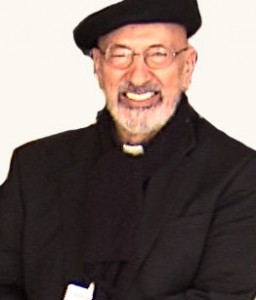 Show 1 ” Building a Kingdom of Love” – “Easter and the Paschal Mystery:  What have we been initiated into“
Show 1 ” Building a Kingdom of Love” – “Easter and the Paschal Mystery:  What have we been initiated into“
[powerpress]
Msgr. Esseff reflects on the readings of the  3rd Sunday of Easter.  By virtue of our baptism, confirmation and reception of the Eucharist, who are we?  We learn what Peter and the community are capable of becoming because of the Pentecost experience.  During this period of Easter, the Church is preparing us to appreciate the gift of the Holy Spirit and the birth of the Church in Pentecost then…and now!  What does that mean for us today?  How are we called to be evangelizers and witnesses of the Truth and authentic Hope?
Msgr. John A. Esseff is a Roman Catholic priest in the Diocese of Scranton. He was ordained on May 30th 1953, by the late Bishop William J. Hafey, D.D. at St. Peter’s Cathedral in Scranton, PA. Msgr. Esseff served a retreat director and confessor to Blessed Mother Teresa.   He continues to offer direction and retreats for the sisters of the missionaries of charity around the world. Msgr. Esseff encountered St.  Padre Pio,  who would become a spiritual father to him. He has lived in areas around the world,  serving  in the Pontifical missions, a Catholic organization established by Bl. Pope John Paul II to bring the Good News to the world especially to the poor. Msgr. Esseff assisted the founders of the Institute for Priestly Formation and continues to serve as a spiritual director for the Institute. He continues to  serve as a retreat leader and director to bishops, priests and sisters and seminarians and other religious leaders around the world. Â
To obtain a copy of Msgr. Esseff’s book byvisiting here
Be sure to visit Msgr. Esseff’s website “Building a Kingdom of  Love”
Tags: catholic, catholic podcast, catholic prayer, cathollc spirituality, Good News, John Esseff, PA, retreat
This entry was posted on Sunday, April 22nd, 2012 at 10:25 am
You can follow any responses to this entry through the RSS 2.0 feed.
Episode 12 Beginning to Pray: Â “Heaven in Faith” Â Day 6 Prayer 2 – “If your eye is single, your whole body will be full of light.“

[powerpress]
Dr. Anthony Lilles is a Catholic husband and father of three teaching Spiritual Theology at St. John Vianney Theological Seminary. He  teaches spiritual theology and spiritual direction to transitional deacons, and the spiritual classics to the men who enter the Spirituality Year, a year of prayer in preparation for seminary formation.  He is the author of the “Beginning to Pray”  catholic blog spot.
From “Heaven in Faith: Day 6 Prayer 2” found in The Complete Works vol 1:
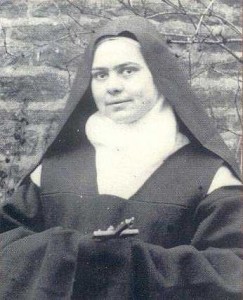
19. …What is this single eye of which the Master speaks but this “simplicity of intention” which “gathers into unity all the scattered forces of the soul and unites the spirit itself to God. Â It is simplicity which gives God honor and praise; it is simplicity which presents and offers the virtues to Him. Â Then, penetrating and permeating itself, permeating and penetrating all creatures, it finds God in its depths.
For other episodes in the series visit the Discerning Hearts page for Dr. Anthony Lilles
We would like to offer heartfelt thanks to
Miriam Gutierrez for providing for us “the voice” of Blessed Elizabeth for this series
Tags: Anthony Lilles, blessed elizabeth of the trinity, carmelites, catholic, catholic podcast, catholic prayer, cathollc spirituality, heaven and faith, Spiritual Theology, St. John Vianney Theological Seminary
This entry was posted on Saturday, April 21st, 2012 at 10:14 am
You can follow any responses to this entry through the RSS 2.0 feed.
What a delight to be joined once again by Vivian Dudro to discuss the work of Spanish novelist Jose Luis Olaizola
and his book “Fire of Love: A Historical Novel on the Life St. John of the Cross”!  Olaizola is an award-winning Spanish writer, who is known for his acclaimed works on great historical figures such as El Cid, Hernan Cortes, Bartolome de las Casas, and Patricio Escobar.  In this book, he richly offers the life of the the great Spanish mystical doctor of the Church, St. John of the Cross.[powerpress]
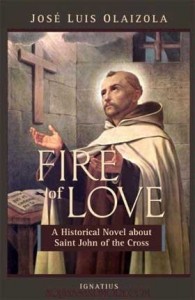 You can find the book here
You can find the book here
This historical novel paints a striking portrait of one of the most revered saints in history, in a landscape that makes the life and times of John of the Cross relevant to our own age. Here is an extraordinary adventure that explores the thorny challenges that every soul must face: avoiding the trappings of this world that lead to darkness, and embracing the radiance of the fire of Divine Love. Having performed the life of this great saint as an actor, I found Jose Luis Olaizola’s portrayal very true to the passion and dramatic intensity of this great mystic. Fire of Love rekindled in me the fire ignited by Saint John of the Cross in his poetic plea, ‘Love Him intensely, as He deserves to be loved.’ May all who read this literary work examine their own souls profoundly, in order to have the greatest of all adventures – finding God Himself. —Leonardo Defilippis, Film Actor & Director, John of the Cross
Tags: catholic, catholic podcast, catholic prayer, cathollc spirituality, Cross Olaizola, doctor of the church, ignatius press, Jose Luis Olaizola, Leonardo Defilippis, mystic, st. john of the cross, work
This entry was posted on Friday, April 20th, 2012 at 10:40 am
You can follow any responses to this entry through the RSS 2.0 feed.
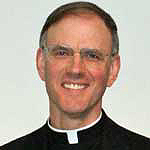 Episode 4Â Praying with Scripture: Christian Contemplation and Mediation in the Ignatian tradition w/Fr. Timothhey Gallagher
Episode 4Â Praying with Scripture: Christian Contemplation and Mediation in the Ignatian tradition w/Fr. Timothhey Gallagher
Fr. Gallagher continues to discuss the differences and benefits of meditation and contemplation – the cornerstones of Ignatius of Loyola’s spiritual practice.
[powerpress]
For other episodes in the series visit The Discerning Hearts “Praying with Scripture†page
Father Timothy M. Gallagher, O.M.V., was ordained in 1979 as a member of the Oblates of the Virgin Mary, a religious community dedicated to retreats and spiritual formation according to the Spiritual Exercises of St. Ignatius. Â Fr. Gallagher is featured on the EWTN series “Living the Discerning Life: Â The Spiritual Teachings of St. Ignatius of Loyola”.
For more information on how to obtain copies of Fr. Gallaghers’s various books and audio which are available for purchase, please visit  his  website:   frtimothygallagher.org
 For the other episodes in this series check out Fr. Timothy Gallagher’s “Discerning Hearts†page
Tags: catholic, catholic podcast, catholic prayer, cathollc spirituality, Christian Contemplation, Father Timothy M. Gallagher, Ignatian tradition
This entry was posted on Thursday, April 19th, 2012 at 11:59 am
You can follow any responses to this entry through the RSS 2.0 feed.
Vatican City, 18 April 2012 (VIS) – Returning to a recent series of catecheses on the theme of prayer, Benedict XVI dedicated his general audience this morning to what has been called the “Little Pentecost”, an event which coincided with a difficult moment in the life of the nascent Church.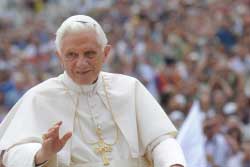
The Acts of the Apostles tell us how Peter and John were released from prison following their arrest for preaching the Gospel. They returned to their companions who, listening to their account of what had happened, did not reflect on how to react or defend themselves, or on what measures to adopt; rather, “in that moment of trial they all raised their voices together to God”, Who replied by sending the Holy Spirit.
“This was the unanimous and united prayer of the whole community, which was facing persecution because of Jesus”, the Pope explained. It involved the community “because the experiences of the two Apostles did not concern only them, but the entire Church. In suffering persecution for Jesus’ sake, the community not only did not give way to fear and division, but was profoundly united in prayer”.
When believers suffer for the faith, “unity is consolidated rather than undermined, because it is supported by unshakeable prayer. The Church must not fear the persecutions she is forced to suffer in her history, but must trust always, as Jesus did in Gethsemane, in the presence, help and strength of God, invoked in prayer”.
Before trying to understand what had happened the first community sought to interpret events through the faith, using the Word of God. In the Acts of the Apostles St. Luke notes how the community of Jerusalem began by invoking God’s greatness and immensity. Then, using the Psalms, those early Christians recalled how God had acted in history alongside His people, “showing Himself to be a God Who is concerned for human beings, Who does not abandon them”, Benedict XVI said. Subsequently the events were read “in the light of Christ, Who is the key to understanding all things, even persecution. The opposition to Jesus, His passion and death were reread … as the accomplishment of the plan of God the Father for the salvation of the world. … In prayer, meditating on Sacred Scripture in the light of the mystery of Christ helps us to interpret current reality as part of the history of salvation which God enacts in the world”.
Thus the plea the first Christian community of Jerusalem made to God in prayer was not “to be defended, to be spared from trials or to enjoy success, but only to be able to proclaim … the Word of God frankly, freely and courageously”. The community also asked that “their proclamation be accompanied by the hand of God so that healing, signs and wonders could be accomplished. In other words, they wanted to become a force for the transformation of reality, changing the hearts, minds and lives of men and bringing the radical novelty of the Gospel”.
“We too”, the Holy Father concluded his catechesis, “must bring the events of our daily lives into our prayer, in order to seek their most profound significance. And we too, like the first Christian community, allowing ourselves to be illuminated by the Word of God and meditating on Sacred Scripture, may learn to see that God is present in our lives, even at moments of difficulty, and that everything … is part of a plan of love in which the final victory over evil, sin and death is truly is that of goodness, grace, life and God”.
Tags: catholic, catholic podcast, catholic prayer, cathollc spirituality, pope benedict xvi
This entry was posted on Wednesday, April 18th, 2012 at 8:26 am
You can follow any responses to this entry through the RSS 2.0 feed.
USCCA7- Episode 7-Â The Good News: Â God Has Sent His Son
[powerpress]
Archbishop Lucas offers insights on the US Catholic Catechism for Adults Chapter 7:
We ponder Christ’s person and his earthly words and deeds in terms of mystery. Â His earthly life reveals his hidden divine Sonship and plan for our salvation. Â His parables, miracles, sermons, and wisdom sayings help us “to see our God made visible, and so we are caught up in love of the God we cannot see” (First Preface for Christmas).
The Most Reverend George J. Lucas leads the Archdiocese of Omaha.Â
For other episodes in the visit our Archbishop George Lucas page
This programs is based on:
More information can be found here.
We wish to thank the USCCB for the permissions granted for use of  relevant material used in this series.
Also we wish to thank Chuck Adams and Miriam Gutierrez for their vocal talents in this episode.
Tags: Archbishop Lucas, catholic, catholic podcast, catholic prayer, cathollc spirituality, George Lucas, jesus christ, united states catechi
This entry was posted on Monday, April 16th, 2012 at 8:16 am
You can follow any responses to this entry through the RSS 2.0 feed.

